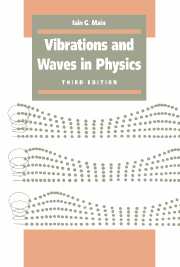Book contents
- Frontmatter
- Contents
- Preface to the first edition
- Preface to the second edition
- Preface to the third edition
- Notes for reference
- 1 Free vibrations
- 2 Free vibrations in physics
- 3 Damping
- 4 Damping in physics
- 5 Forced vibrations
- 6 Forced vibrations in physics
- 7 Anharmonic vibrations
- 8 Two-coordinate vibrations
- 9 Non-dispersive waves
- 10 Non-dispersive waves in physics
- 11 Fourier theory
- 12 Dispersion
- 13 Water waves
- 14 Electromagnetic waves
- 15 De Broglie waves
- 16 Solitary waves
- 17 Plane waves at boundaries
- 18 Diffraction
- Answers to problems and hints for solution
- Constants and units
- Index
10 - Non-dispersive waves in physics
Published online by Cambridge University Press: 05 June 2012
- Frontmatter
- Contents
- Preface to the first edition
- Preface to the second edition
- Preface to the third edition
- Notes for reference
- 1 Free vibrations
- 2 Free vibrations in physics
- 3 Damping
- 4 Damping in physics
- 5 Forced vibrations
- 6 Forced vibrations in physics
- 7 Anharmonic vibrations
- 8 Two-coordinate vibrations
- 9 Non-dispersive waves
- 10 Non-dispersive waves in physics
- 11 Fourier theory
- 12 Dispersion
- 13 Water waves
- 14 Electromagnetic waves
- 15 De Broglie waves
- 16 Solitary waves
- 17 Plane waves at boundaries
- 18 Diffraction
- Answers to problems and hints for solution
- Constants and units
- Index
Summary
Before going on to discuss other wave equations, we pause to examine a few physical systems which obey (exactly or approximately) the nondispersive form of wave equation (9.3), or its damped version (9.37). We start by outlining our general approach, which involves three steps:
(1) We first identify the return force acting at a point z. In our examples we shall always find that the size of this force is proportional to some gradient ∂ψ/∂z where ψ is the variable which measures the particular disturbance being propagated. (For a transverse disturbance on a string, ∂ψ/∂z is simply the slope of the string.)
(2) From the return force at the point z we deduce the return force acting on a segment of length Δz. That there is such a force follows from the fact that the return force will usually vary with its position z, so that the forces at the two ends of a segment do not balance each other. If the return force at point z is F, and the return force at point z + Δz is F + ΔF, then the segment will be both strained (by the balanced forces F) and accelerated (by the unbalanced force ΔF). Since F is proportional to ∂ψ/∂z then ΔF will be proportional to ∂2ψ/∂z2. (For the model system this quantity simply measures the curvature of the string.)
(3) We apply Newton's second law to the segment. For a vanishingly small segment the result is the wave equation.
- Type
- Chapter
- Information
- Vibrations and Waves in Physics , pp. 173 - 191Publisher: Cambridge University PressPrint publication year: 1993
- 1
- Cited by



